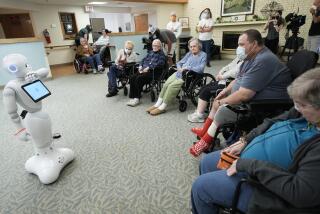Back to Work
- Share via
Despite a continuing decline in job-related ailments among most American workers, legions of nursing-home aides keep coming down with painful back sprains and other injuries.
In a federal job-safety ranking released last month, nursing homes came out as the 12th most hazardous industry among the more than 300 businesses tracked. That’s worse than any of the construction fields and is in roughly the same category as shipbuilders and truck drivers.
But a recent pilot project in the Bay Area illustrates that some relatively simple solutions might go a long way toward solving injury problems among nursing- home workers. It also reflects how common-sense approaches are helping employers and workers reduce injuries in other industries.
The main hazard to workers in the nursing-home field involves lifting or moving patients. Nursing homes have manual equipment to help, but it’s often so awkward to operate that aides don’t bother using it. The result is a lot of back injuries among the low-paid nursing aides who shift patients dozens of times a day, typically moving them between their beds and wheelchairs.
At the Vale Health Care Center in the Contra Costa County city of San Pablo, there were about 10 back injuries every year among the 70 aides on the nursing home’s staff. Then, a year ago, a federally funded injury-prevention project conducted with UCLA’s Labor Occupational Safety and Health Program was launched.
Nursing aides were put through two injury-prevention training sessions totaling 3 1/2 hours. A labor-management committee was set up to review injury problems.
Probably most important of all, Vale replaced some of its old patient-lifting equipment with two easier-to-use, electrically powered $4,000 machines.
The result: Only one nursing aide suffered a back injury during the first half of this year, and that mishap involved a worker who wasn’t using one of the new lifts.
“It’s a little soon to crack open the bottle of champagne, but you can’t deny that things are moving in a positive direction,” said Diane Factor, an industrial hygienist from UCLA who directed the pilot project at Vale.
The new equipment already appears to have paid for itself, said Valerie Paynter, Vale’s staff development director.
“If you consider what it saves you in injury costs, it’s really not expensive,” Paynter said.
In fact, the company’s expenses stemming from workers’ patient-handling injuries totaled nearly $50,000 over 1995 and 1996.
But if the solutions are so simple, why aren’t more nursing homes taking similar approaches?
A key obstacle, along with the equipment cost, is mistrust between workers and management.
“Without worker involvement, you can’t solve the problem, and some companies are afraid of worker involvement,” Factor said.
At Vale, however, the program won crucial support from both management and the union, and the staff embraced the new equipment.
“The machine is wonderful,” said Levette K. Houchins, head of the back-injury prevention committee and a union shop steward at Vale. “A lot of people don’t like new things. But once they got used to the new equipment, they started to use it all the time.”
More new equipment is on the way. Vale plans to buy two more electrically powered lifts, and its Atlanta-based parent company, GranCare Inc., is beginning similar injury-prevention programs at two of its other nursing homes in the Bay Area.
Areas of Growth Reflecting the state’s continuing economic expansion, three regions in California earned spots on a list of the 20 U.S. metropolitan areas expected to show the strongest job growth through the year 2002. The list, from the Lexington, Mass.-based economic consulting firm DRI/McGraw-Hill, included Riverside-San Bernardino, fourth; Sacramento, ninth; and Vallejo, 16th. Las Vegas finished first.
Times staff writer Stuart Silverstein can be reached by phone at (213) 237-7887 or by e-mail at stuart.silverstein@latimes.com
More to Read
Sign up for Essential California
The most important California stories and recommendations in your inbox every morning.
You may occasionally receive promotional content from the Los Angeles Times.













